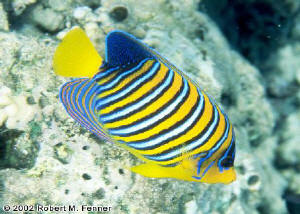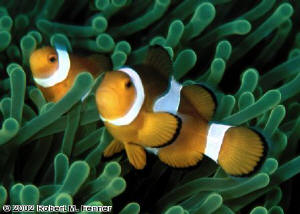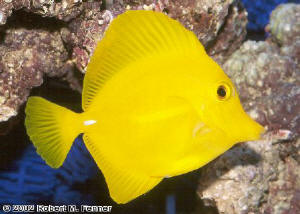
by Mark E. Evans
The fantastic array
of colors found in tropical reef fishes is what draws many of us to become
involved in marine aquarium keeping in the first place. Vibrant images of grand
structures like the Great Barrier Reef, with its collection of sessile and
motile inhabitants are what typically pique our fascination with marine
creatures. But consider for a moment that the spread of colors exhibited amongst
these animals is not that different from an artist’s palette. The blending of a
limited number of primary colors yields new paint mixtures for the artist.
Analogously, in the
great oceanic food chain there is a vast source of basic pigments formed by the
primary producers (photosynthetic bacteria and algae) which through feeding,
metabolic processes and conversions eventually end up within the tissues of
fishes, giving them their colorations. But unlike an artist’s palette, the basic
pigments of the lowly primary producers have a greater purpose than for mere
visual stimulation or esthetic appeal. They are vital to the nutritional content
of marine food sources and to the very maintenance of fish health. In essence,
they are part of a complex of nutrients found within natural oceanic foods and
therefore should be a consideration for any aquarist who is dedicated to
providing the best of care for their captive marine fishes.
 |
|
The Regal Angel, Pygoplites
diacanthus displays a variety of colors from a variety of sources,
including pigments, refraction and melanins. Photo by Robert
Fenner |
The natural
pigments, distributed in the fatty-tissues of marine fishes and invertebrates,
mostly begin as products synthesized within the tissues of photosynthetic
bacteria, algae, and higher plants. These yellow-to-orange-red pigments, called
carotenoids, of which there are over 600 hundred different chemical
formulations, are typically divided into two subgroups, the carotenes, or
hydrocarbon carotenoids, and the xanthophylls, or oxygenated carotenoids.
The carotenoid family of pigments, while not responsible for all fish
colorations, is the most widespread of pigments in marine ecosystems. Adding to
the great variety of carotenoid pigments already in existence, many organisms
have the physiological ability to chemically alter pigments obtained from their
food sources, thus producing new color variations. Also, carotenoids deposited
within the fatty-tissues of animal structures interact by overlaying base
colors. An example is the Pink Flamingo, a bird that obtains its pink coloration
from minute crustaceans it sifts from shallow waters with its down-turned bill.
Captive flamingos fed a diet lacking in carotenoids lose their proper coloration
and turn white. Another more familiar example to marine aquarists, is the Yellow
Tang (Zebrasoma flavesens) which often fades and develops white patches
when deprived of algae or other greenery in its diet. For this reason many
prepared foods specifically designed for marine fishes contain sources of
xanthophylls like algae.
There are a series
of physical mechanisms within the cellular and anatomical structures of fishes
that enable them to reflect and to refract light and more importantly, to
display colors obtained from dietary sources. The physical characteristics of
fish skin are part of the key to how this is all accomplished. First, there is
the epidermis. The epidermis is most often transparent and is the very
thin outer layer of the skin. The epidermis can contain mucous glands,
sensory cells (taste buds and alarm cells) and pigment cells. Scales, if they
are present, lie below the epidermis in pockets as part of the dermis. (Fish
scales are generated in the dermal layer and are not shed like those of
reptiles, which are epidermal in nature). The dermis contains pigment cells of
various kinds. Pigments cells in general are called chromatophores. Individual
chromatophores may contain several types of pigments. Each pigment is
produced or contained in separate cellular organelles called chromatosomes. The
transparency of the scales and the thinness of the epidermal layer are what
allow the dermal pigments of the chromatophores to show through the skin for
display.
Basic melanin
pigments like black and brown, interestingly enough, are not obtained from
dietary sources like bacteria, algae, or plants. Instead, they are protein-based
pigments manufactured within pigments cells called melanophores. The almost
all-black coloration of a juvenile Domino Damsel (Dascyllus trimaculatus)
is one example of melanin pigmentation. The pattern of vertical bars in the
Convict Surgeon (Acanthurus triostagus) and the complex arrangement of
the Clown Triggerfish (Balistoides conspicillum) are others. But whether
the pigment is manufactured in the cells or concentrated from a dietary source,
it is the physiological mechanism of chromatophores that allow for the changing
of color, pattern, and intensity in fishes. The various intracellular
pigment-containing organelles can be concentrated in the cell or diffused
throughout it. If they are diffused, the color is presented as more intense, and
if they are concentrated the colors is muted. This cellular mechanism enables
fishes to alter the intensity of color according to background, lighting
conditions, and behavioral mood.
Another source of
perceived color in fishes is refraction. Refracted or scattered colors are
not actually the result of pigments but are created by crystalline intracellular
deposits. Concentrated within cells called iridiophores, these chemicals bounce
light in such a way that the reflected colors change depending on the angle of
reflection.
 |
|
The false percula clown (Amphiprion
Ocellaris) is a darling of the captive breeding industry. Early
breeders learned quickly that if breeding clownfish and their fry were
denied the proper pigments in their diet, not only would they lack bold
coloration, but the fry would fail to develop and mature properly.
Thankfully for commercial interests, pigment concentrates are available
as food additives. Photo by Robert Fenner |
The deposition of
carotenoids is not limited to the skin of fishes. Nor is the basic coloration
provided by carotenoids the only biological function of the pigments.
Carotenoids are fat-soluble and can be deposited in tissues throughout a fish’s
body, including skin, muscle, fins, eggs, gonads, milt, and sensory organs like
the eye. The layering of pigments in the skin, along with the cellular
manipulation of pigments, allows fish to change color for cryptic, behavioral,
or communication purposes. Many fish species in spawning condition exhibit color
changes which can be attributed to nutritional triggers such as a surplus of a
particular food source. Carotenoids within females are passed on to eggs and fry
and the bright red or pink colors typically found in fish eggs can be a signal
for fertilization or for parental care to begin. A major function of
carotenoids, other than coloration, is as a provitamin, or precursor to the
synthesis of vitamins. An important nutrient for most animals is vitamin A.
Vitamin A cannot be synthesized by plants, but it is essential for the proper
vision, growth, immunity, and reproduction of fishes. Fishes do have the ability
to chemically convert some carotenes into vitamin A, often by splitting of a
molecule. Another example of the nutritional value of pigments is astaxanthin.
Astaxanthin is a red pigment from the xanthophyll oxygen-carrying group of
carotenoids and is considered to be a powerful antioxidant... one hundred times
more powerful than vitamin E. Research suggests that astaxanthin functions as a
intracellular oxygen reserve and fishes and invertebrates fed on a diet
containing optimal levels of astaxanthin show greater survivability rates when
subjected to poor oxygen environments. Lastly, as a pigment, astaxanthin
provides a degree of photo protection for reef fishes and invertebrates, which
both must survive in clear waters flooded with ultra violet light. Proper
deposition of such pigments in the eyes and skin of marine creatures is
necessary for long-term survival and maturation.
Fulfilling the
nutritional requirements of marine aquarium fishes for carotenoid pigments (just
like their overall nutritional requirements) in their prepared foods is
inherently connected to the natural feeding methods of the fish species in
question. For example, there are the grazing species like damselfishes, tangs,
and blennies, which browse continuously on algae. They obtain the essential
carotenoid (xanthophylls) pigments from consuming green, red, and blue-green
algae. Certain species of damselfishes (Stegastes and Garabaldi), keenly
"farm" small patches of filamentous algae in the natural habitats, fiercely
keeping away any intruders. Many species of Tang (Acanthurus and
Zebrasoma) school over reefs picking at targeted filamentous algae. Blennies
like the Jeweled Rockskipper (Salarius fasciatus) rasp surrounding
surfaces of micro-algae growth. To achieve a proper regiment of feeding these
types of fishes, different sources of food must be employed. Relying on surface
algae growth in an established marine aquarium to support grazers may not be
adequate. Grazers are quick to reduce excess algae growth.
 |
|
The ever-popular yellow tang (Zebrasoma
flaviscens) will become pale and develop patchy coloration if it
does not receive a diet rich in natural pigments. Photo by Robert
Fenner |
Remember that
herbivorous material takes longer to digest, so grazers must feed almost
constantly in order to remain healthy. Unfortunately, this makes herbivores
prone to malnutrition if food is in short supply. But a diet of algae growth can
be supplemented with sheets of dried macro-algae specifically prepared for
marine aquarium fishes, or even with sheets of Nori, which is used in wrapping
sushi. Feeding spirulina (blue-green algae)- based flake foods is also an
excellent addition to a grazer’s diet. If brine shrimp are offered to the
grazing fish and if they are accepted eagerly, then the aquarist can easily rear
the brine shrimp on algae powder so the needed carotenoids will be passed on to
the fish when consumed. (Gut-loading, as it is called, is a common practice in
other hobbies like reptile-keeping) but natural and more direct sources of algae
are always better, since fish can graze on them at will throughout the day
instead of at the designated feeding times. Aquarists who utilize an
algae-scrubber filter can remove the scrubber plates, the surfaces covered with
the micro-algae growth, and place them directly in the main aquarium where the
fish can nibble them clean. Or if a lighted sump or refugium is utilized,
different types of filamentous algae can be grown and harvested for the fish.
For many species of
small fishes, which feed on drifting zooplankton in their natural habitat, and
rely on this as their primary nutritional source, the proper prepared foods in
the confines of a marine aquarium is paramount. Fishes like Anthias,
Clownfishes, Dottybacks, Dartfishes, and Grammas pick at a variety of
drifting particular foods like crustaceans, invertebrate and fish larvae, and
planktonic eggs, to name a few. The pigments obtained from these foods begin in
the primary producers and are passed along in the food chain to the zooplankton
and then on to the zooplankton feeders. Fishes that employ this feeding method
are accustom to some level of water movement and require several small feedings
per day. Small crustaceans like mysid shrimp and brine shrimp, or color
enhancing flake foods that contain carotenes are ideal for these fish species.
Finally, there are
the marine fish species that come under the general grouping of piscivores. (The
distinction here is that the carnivore may eat animal flesh regardless of size
or type, from a small crustacean to a coral polyp to another fish, whereas the
piscivore is defined as specifically eating fish). This behavior, which can
clearly be a disadvantage in a tank of ornamental fishes, is found among species
of Lionfish, groupers, Moray Eels, Frogfishes, and of course, sharks. To
accommodate a piscivore’s dietary needs, meaty pieces of marine fish and
crustacean should be offered a few times per week. Any live foods offered,
regardless of whether they are fish or crustaceans, should be well reared on
carotenoid rich foods. But taking into consideration the fact that obligate
carnivorous fish eat less frequently than obligate herbivorous fish and are
often prone to malnutrition, vitamins enrichment of the food offered as well as
loading of the food with algae may go a long way to enhance a piscivore’s diet
and health. (Even strict carnivores like lions and tigers obtain plant material
in their diets from devouring herbivorous prey. The gut contents, or undigested
plant material, of the deceased herbivorous animals are passed on to the
carnivorous predators). All the nutritional requirements of piscivorous fishes
including important carotenoids are passed along in the food chain from their
algae eating and plankton eating prey. So, adding some type of carotenoid
enhancement to the foods offered to piscivorous fishes is helpful in fulfilling
their complex nutritional requirements and in maintaining their pleasing colors.
[Editor's note: Prey items for larger predators can literally be stuffed
or injected with commercial fish foods, vitamins or other supplements.]
In the end,
pigmentation in tropical marine fishes is a subject more involved than the
simple display of colors and patterns. The vast array of colors exhibited
amongst reef fishes has a far greater purpose than for visual stimulation,
cryptic coloration, or warning displays. There are intricate microbiological and
physiological functions associated with the pigments deposited in the tissues of
fishes. The various pigments are essential for proper growth, immunity, and
reproduction. And as marine aquarists, we must appreciate the fact that a
healthy level of these pigments must be maintained in the diets of our aquarium
fishes. The natural food chain provides for the distribution of pigments in the
wild, all the way from the bottom primary producers to the top consumers. But
within the confines of our home aquariums, our diligence and intervention is
required in providing these vital nutrients.
References
Adey, Walter H. and
Loveland, Karen; Dynamic Aquaria: Building Living Ecosystems; Academic
Press Inc., 1991
Gratzek, John B.
(Editor); Aquariology: The Science of Fish Health Management; Tetra Press
Publication, 1992
Love, R. Malcolm;
The Chemical Biology of Fishes; Academic Press, 1970
Moyle, Peter B. and
Cech Jr., Joseph J.; Fishes: An Introduction to Ichthyology;
Prentice-Hall Inc., 2000
Spotte, Stephen;
Captive Seawater Fishes: Science and Technology; John Wiley & Sons Inc.,
1992
Stoskopf, Michael
K.; Fish Medicine; W. B. Saunders Company, 1993
